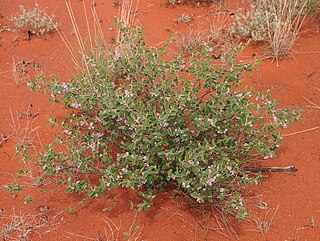| Rulingia | |
|---|---|
| Scientific classification | |
| Kingdom: | Plantae |
| Clade: | Tracheophytes |
| Clade: | Angiosperms |
| Clade: | Eudicots |
| Clade: | Rosids |
| Order: | Malvales |
| Family: | Malvaceae |
| Subfamily: | Byttnerioideae |
| Tribe: | Lasiopetaleae |
| Genus: | Rulingia R.Br. |
| Type species | |
| Rulingia pannosa R.Br. | |
| Species | |
See text | |
Rulingia is a genus of flowering plants native to Australia and Madagascar. [1] In 2011, all species were transferred to Commersonia with the exception of Rulingia cuneata , R. loxophylla , R. luteiflora and R. procumbens which have been transferred to the new genus Androcalva .
Species formerly placed in the genus included: [2]
- Rulingia borealis(E.Pritz.) C.F.Wilkins (now Commersonia borealis (E.Pritz.) C.F.Wilkins & Whitlock )
- Rulingia corylifoliaGraham (now Commersonia corylifolia (Graham) C.F.Wilkins & Whitlock ) – hazel-leaved rulingia
- Rulingia craurophylla F.Muell. (now Commersonia craurophylla (F.Muell.) F. Muell.) – brittle leaved rulingia
- Rulingia cuneataTurcz. (now Androcalva cuneata (Turcz.) C.F.Wilkins & Whitlock)
- Rulingia cygnorum(Steud.) C.A.Gardner (now a synonym of Commersonia corniculata (Sm.) K.A.Sheph. & C.F.Wilkins)
- Rulingia dasyphylla(Andrews) Sweet (now Commersonia dasyphylla Andrews ) – kerrawang
- Rulingia densiflora(Turcz.) Benth. (now Commersonia densiflora (Turcz.) F.Muell.)
- Rulingia grandiflora Endl. (now Commersonia grandiflora (Endl.) C.F.Wilkins & Whitlock)
- Rulingia hermanniifolia(J.Gay ex Kunth) Endl. (now Commersonia hermanniifolia J.Gay ex Kunth)
- Rulingia loxophyllaF.Muell. (now Androcalva loxophylla (F.Muell.) C.F.Wilkins & Whitlock)
- Rulingia luteifloraE.Pritz. (now Androcalva luteiflora (E. Pritz.) C.F.Wilkins & Whitlock)
- Rulingia madagascariensis Baker (now Commersonia madagascariensis (Baker) C.F.Wilkins & Whitlock) [3]
- Rulingia magniflora F.Muell. (now Commersonia magniflora (F.Muell.) F. Muell.)
- Rulingia malvifoliaSteetz (now a synonym of Commersonia corniculata (Sm.) K.A.Sheph. & C.F.Wilkins)
- Rulingia parviflora Endl. (now Commersonia parviflora (Endl.) F.Muell.) – small-flowered rulingia
- Rulingia platycalyxBenth. (now a synonym of Commersonia parviflora (Endl.) F.Muell.)
- Rulingia procumbens Maiden & Betche (now Androcalva procumbens (Maiden & Betche) C.F.Wilkins & Whitlock)
- Rulingia prostrataMaiden & Betche (now a synonym of Commersonia prostrata (Maiden & Betche) C.F.Wilkins & Whitlock) – dwarf kerrawang
- Rulingia rotundifoliaTurcz. (now Commersonia rotundifolia (Turcz.) F. Muell.) – round-leaved rulingia
- Rulingia rugosaSteetz (now Commersonia rugosa (Steetz) F. Muell.)
- Rulingia salviifolia(Hook. ex Steetz) Benth. (now Commersonia salviifolia (Hook. ex Steetz) F.Muell.)
- Rulingia tratmanniiC.R.P.Andrews (now a synonym of Commersonia craurophylla (F.Muell.) F. Muell.)














